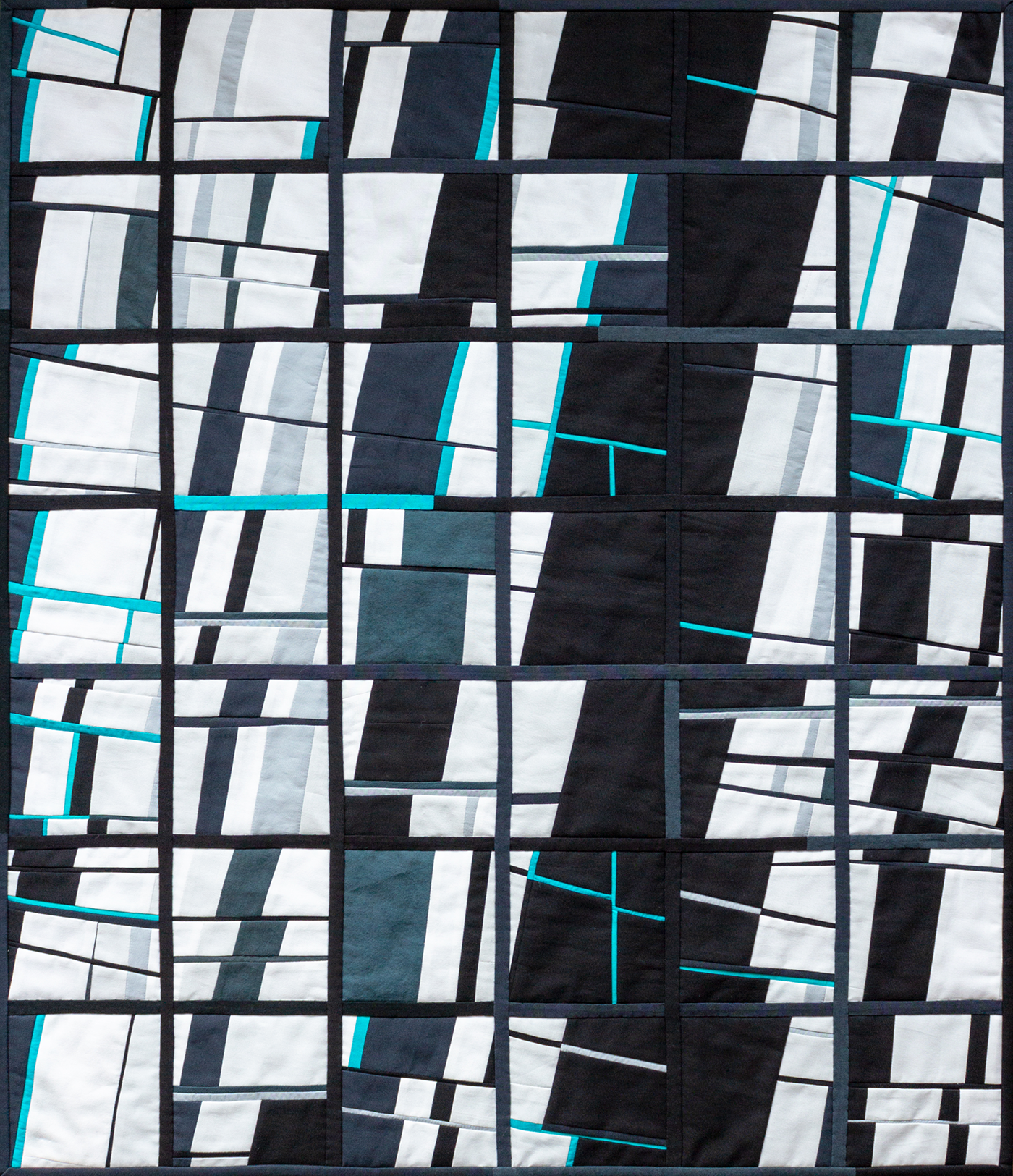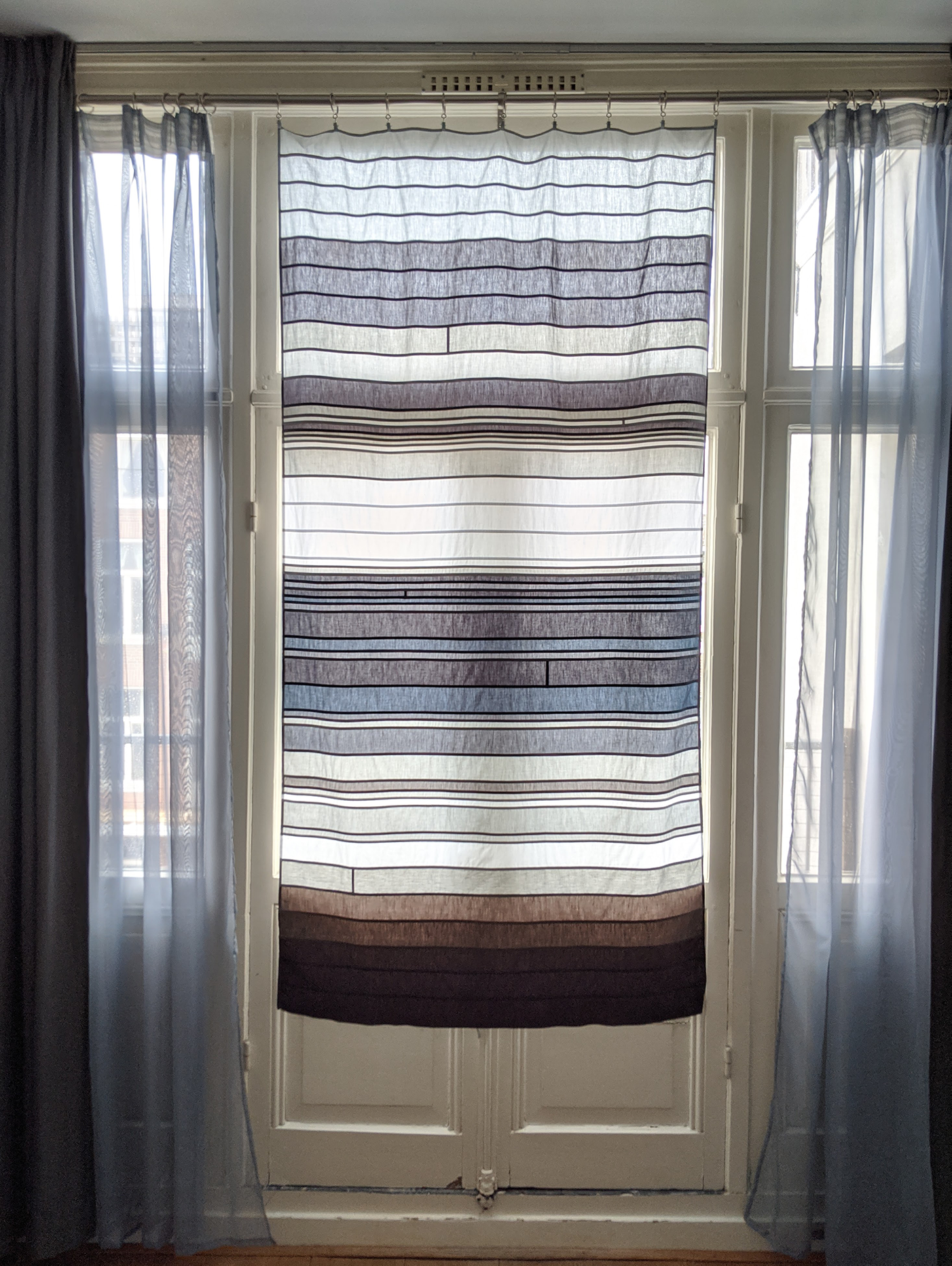Lucinda Walker
Lucinda Walker is an American textile artist living in Amsterdam, Netherlands. After earning her BFA in Ceramics and Textiles from The California College of the Arts, she apprenticed with a ceramic tile maker and studied commercial textile design in Berkeley, CA. Her process remains consistent throughout a range of mediums: combining small repeating elements while building a large, often abstract image. In 2014 she constructed her first quilt, and she has remained immersed in the medium since. Her quilts have been exhibited at quilt shows internationally and have achieved recognition through awards and publications.
In 2020, a year of unprecedented pandemic and political unrest, Lucinda’s textile work has undergone a shift in tone from her soft, calming compositions of the past decade. Letting go of the practical constraints of utilitarian quilt construction, she is making non-functional pieced fabric works involving bold imagery of cracks and fragmentation.
Revision - quilt (sewn cotton fabric, batting) - 27" x 27"
Revisited - quilt (sewn cotton fabric, batting) - 31" x 27"
Muscle Memory - sewn cotton fabric - 32" x 24"
Foundation - sewn cotton fabric - 5.5" x 3.5"
The Way Home - sewn cotton fabric - 7" x 5"
The Mirror - sewn cotton fabric - 14" x 20"
Resurface - sewn cotton fabric - 11" x 8"
Crucible - sewn cotton fabric - 7" x 5"
Intrusion - sewn cotton fabric - 11" x 8"
The Wrecking Ball - sewn cotton fabric - 14" x 18"
One Thousand Cuts - sewn cotton fabric - 30" x 40"
Broken Record - sewn cotton fabric - 40" x 40"
Broken Record (detail) - sewn cotton fabric
Flux - quilt (sewn cotton fabric, batting) - 76"x63"
Flux (detail) - quilt (sewn cotton fabric, batting)
Non-stop Flight - quilt (sewn cotton fabric, batting) - 16" x 16"
Sea Horizon, West - quilt (sewn cotton fabric, batting) - 52" x 42"
Sunset, electric - quilt (sewn cotton fabric, batting) - 12" x 12"
Sunset, purple - framed quilt (sewn cotton fabric, batting) - 14" x 11"
Horizon window hanging - sewn cotton fabric - 85" x 40"
Horizon window hanging (detail) - sewn cotton fabric
You’re a new addition to the crayon box: what color are you?
Right now my dreamiest color is one I would call “Darkest Teal” - an underwater green-blue-black. Picture a base of Payne’s Gray, with a little more black, and just the teeniest dab of Viridian.
What is your earliest memory of art?
I think I remember making my own art before I had any concept of what “Art” really was. I was constantly creating as a child: coloring with crayons, building with blocks, cutting up construction paper, playing with yarn. I don’t have a very linear memory, so I don’t know what came first. But my memories of art-making feel very happy and safe, and also quite solitary. It was my own world where I had absolute freedom.
How did you become a practicing artist?
I’ve always been a practicing artist, though not always a professional one. I have found joy in art and crafting throughout my life, regardless of what I was doing for a living. Encouragement from my high school boyfriend and my art teacher led me to consider art school. I ended up enrolling and graduated with honors, but afterward, I didn’t have a clue how to make a career in art sustainable. I worked full time at a ceramic tile showroom and began studying commercial textile design in the evenings. My personal artmaking was on the sidelines and sporadic. Later, I was able to quit my job and focus exclusively on my art. It’s been an incredible opportunity which I am thankful for every day. But it's still not an easy life to navigate. Practicing the profession of art involves so much more than just the art-making, and it can change your relationship to the work. I am constantly on the fence about whether to push to make my art bring in more money or to get a regular job and let my art-making be more relaxed.
What prompted you to move to Amsterdam?
My husband received a job offer from a game studio in Amsterdam. It seemed like a once-in-a-lifetime opportunity to live in one of the most beautiful cities in Europe, with a progressive culture, easy access to the rest of the continent, and one of the largest concentrations of museums per capita. So we sold almost everything we owned, and we emigrated with our cat. We’ve been here since early 2019. The first year in such a new situation can present some difficult adjustments, and then the second year, we’ve had this pandemic. So it’s been a bit trying, but also incredible. I love it here, and I hope to stay long enough to get everything I can out of it.
What does a typical studio day look like for you?
I have a tiny studio/sewing room separated from our little fourth-floor walkup by a short exterior hallway. It’s a laundry room, really. I have a little portable sewing machine, an ironing board, and one wall covered in felt where I can stick up fabric pieces to try out different arrangements before sewing. On a typical day, I enter the studio after lunch, having spent the morning on computer work or household tasks. Once in the studio, I turn on an audiobook or podcast and jump into whatever project is in progress. If I’m between projects, I work in silence, writing in my sketchbook, designing the next piece, or pulling fabrics to assemble a color palette in the daylight. I work until about 6:30 when I cook and eat dinner with my husband, and then I either go back into the studio after dinner, or we spend the evening together.
You practice with a lot of different mediums: ceramics, painting, textiles. What is the common thread that connects these different mediums that shows your distinct artistic style?
Much of my work involves small flat units that combine to make larger compositions. Such as the pieces of fabric that make a quilt, ceramic tiles that together to form an image, or even the progressions of lines that I used in my horizon paintings. Whatever my medium, I work in repeated motifs. I love to see how patterns and anomalies develop, and how simple elements combine to form complex systems.
My work also tends to deal with a sense of space or place, and an associated mind-state. In addition to playing with flattening the depth perspective, my horizon work (both the paintings and the quilts) was about a sense of peace and calm, situated between the ocean and the sky. My newer textile work brings up ideas about permanence and trauma through the metaphor of geology: the earth is a stand-in for the body and the mind. These sorts of concepts will probably reappear in whichever mediums I try in the future.
What is your favorite tool(s) to create with?
If I had to choose a favorite, it would be my best Kai fabric scissors and the leather “holster” where I carry them on my belt. But no single tool does all things! I love tools. In the past, I amassed quite a collection of art materials, but moving to Amsterdam, I needed to pare down and live more simply. I parted with probably 90% of my studio contents and brought with me only the essentials and the things which truly bring me joy. Also, I’m a compulsive organizer of things, so having just what I need right where I need it is a big studio m.o. for me. I have a wooden tray on my sewing table which holds my most frequently used tools: thread snips, hera marker, rulers, mechanical pencil, pointy tweezers, seam ripper, awl, a #11 crochet hook, a leather thimble, a variety of needles, my Kai scissors, a rotary cutter, and a matryoshka doll pincushion that I made.
What is your go-to medium?
I love tactile mediums, and I love to work with what I have access to wherever I happen to be. At this moment, I’m working in fabric and thread. I feel a strong connection to textiles, to their physicality, their pliability, and their versatility, to the history of women’s work and the household/domestic arts. But I don’t feel like I’m married to any particular medium. I still love clay. And I feel like a lot of what I’m trying to say with fabric could be done with paper. But I don’t have a lot of paper and I do have a lot of fabric, so I use what’s here.
Where do you draw inspiration from? Can you name some other artists who inspire you?
I am continually inspired by just being in the world: settings, places, landscapes. Fleeting plays of light. The sky. Occurrences or patterns that mirror each other on micro and macro scales. Internal processes that mirror external/geological processes. Trying to see the world the way it might look to a being wholly unfamiliar with it.
I find a new artist to be inspired by nearly every day.
A short list includes Agnes Martin, Franz Kline, Piet Mondrian, Kazimir Malevich, Lonnie Dean, Carson Converse, Irene Roderick, Adam Pogue, Debra Smith, Jon Poblador, Heather Jones, Jen Broemel, Cheryle Rome-Beatty.
How has quarantine changed your practice?
Studio work can be fairly isolating, but since the rise of covid-19, I make time for regularly scheduled phone calls or video meetups with other artist friends. We discuss what we’re working on and share ideas, advice, and struggles. I might even be more social now than I was pre-covid!
Cocktails with the Curators
Curators Vanessa and Liz are back to share artwork from Lucinda Walker, this months feature at gallerybaird.com with special guest Bartender Rene Jàquez.
Artist: Lucinda Walker
@lucindawalkerart on Instagram
Piece: "The Way Home"
Guest Bartender: Rene Jàquez
@poodlesaurus on instagram
“The fertility vase of the Ndebele tribe”
Cocktail Specs:
1 oz Caravedo Pisco Mosto Verde
.75 oz Farro and Quinoa Orgeat (recipe below)
.75 oz Cumbé Aguardiente
.5 oz Mace Syrup (recipe below)
.25 oz Fresh Lemon Juice
1 spoonfulI of fresh Passion Fruit pulp
Orgeat Roast: 1 pint of raw Farro at 350 degrees for 10-15 mins or until golden. In a blender add the toasted farro and 2 quart of Oat Milk and blend until smooth. Add equal parts of sugar and stir until all is incorporated. Run mixture through a wet cheesecloth and strain. Store and label.
Mace Syrup: In a container mix 2 tablespoons of dried mace, 1 tablespoon of clove, 3 anise stars and 5 sprigs of oregano and one pint of sugar. Fill the container with a quart of hot water. Let sit for an hour Strain and store.






















